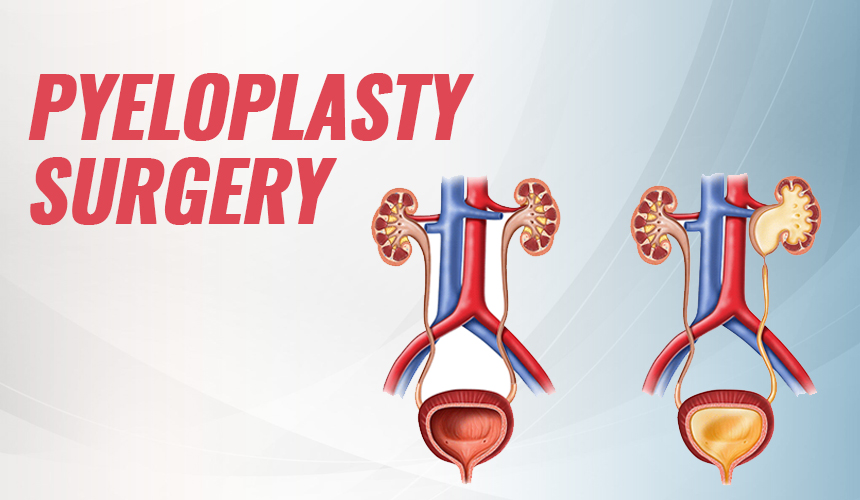Pyeloplasty Surgery in Bangalore
A pyeloplasty is a procedure used to treat pelviureteric junction obstruction. The pelviureteric junction is the junction between the kidney and the ureter.
Why is a pyeloplasty operation performed?
A pyeloplasty is done to cure the condition where the tube that takes urine from the kidney and into the bladder is obstructed, causing the urine to flow back into the kidney. If not treated at the proper time, it may result in infections, pain, and a reduction in renal function. Pyeloplasty surgery can aid in addressing these problems and prevent them from recurring or getting worse.
A pelviureteric junction (PUJ) obstruction can be primary since birth or secondary or acquired. In primary PUJO, an adynamic segment of the ureter or rarely a crossing vessel can result in a narrowing that obstructs the flow of urine. Secondary causes include stones, Reflux disease, benign strictures, and malignancy. Ultrasounds and other imaging tests like a CT Urogram or a Nuclear scan called a Renogram can be done to determine the cause of the obstruction and whether surgery is required or not. Significant obstruction, deteriorating function and pain are the usual indications for a pyeloplasty.
Types of Pyeloplasty Surgery
- Open Pyeloplasty: This traditional approach involves making an incision to reconstruct the narrowed or blocked ureteropelvic junction, improving urine flow and drainage. It's suitable for complex cases and provides thorough visualization of the area.
- Laparoscopic Pyeloplasty: Using minimally invasive techniques, this procedure involves smaller incisions and the insertion of a camera and instruments. It offers reduced pain, shorter hospital stays, and faster recovery compared to open surgery.
- Endopyelotomy: A minimally invasive option, this procedure involves inserting a small instrument through the ureter to incise and dilate the narrowed area. It's ideal for certain cases of ureteropelvic junction obstruction and offers a quick recovery.
- Balloon Dilation Pyeloplasty: In this procedure, a deflated balloon is guided to the narrowed junction and inflated to widen the passage. It's less invasive than other methods, but success rates can vary and it's suitable for specific cases.
- Robotic-assisted Laparoscopic Pyeloplasty: Combining the benefits of laparoscopic and robotic techniques, this approach provides precision and reduced invasiveness. A robot-assisted pyeloplasty only necessitates a minor incision to fit the robotic arms and surgical instruments. Four arms are accessible where two serve as the surgeon's arms, a fourth arm is employed to hold back tissue, and one is outfitted with a high-resolution 3-D magnifying camera. The surgeon can see more detail, a real depth of field, and a panoramic picture thanks to the camera, and the robotic hands' wide range of motion furnishes more proficiency and accuracy, which are essential for reconstructive procedures of the urinary system. While settled at the console, a short stretch from the patient, the surgeon controls the robotic arms remotely and efficiently.
Benefits of Robotic Pyeloplasty Surgery:-
- Less bleeding
- Minimum scarring
- Minimum medication and post-operative discomfort
- Faster healing and resumption of regular activities
After undergoing pyeloplasty surgery, your urologist will provide specific post-operative care instructions to ensure a smooth recovery. Here are some common guidelines they might recommend:
- Medication Management: Take prescribed pain medications, antibiotics, and any other medications as instructed by your urologist to manage pain, prevent infections, and promote healing.
- Incision Care: Keep the incision site clean and dry. Follow your urologist's guidelines for changing dressings and caring for the wound. Notify them if you notice any signs of infection, such as redness, swelling, or discharge.
- Fluid Intake: Stay adequately hydrated by drinking water and clear fluids. Proper hydration supports the healing process and prevents urinary complications.
- Physical Rest: Allow your body to rest and recover during the initial days after surgery. Avoid strenuous activities, heavy lifting, and vigorous exercise.
- Diet: Follow the dietary recommendations provided by your urologist. A balanced diet with sufficient nutrients can aid in your recovery.
- Mobility: Gradually resume light activities and short walks as advised by your urologist. This helps prevent blood clots and promotes circulation.
- Follow-up Appointments: Attend all scheduled follow-up appointments with your urologist. These visits are important for monitoring your progress and addressing any concerns.
- Catheter Care: If a urinary catheter was placed during surgery, follow your urologist's instructions for catheter care, hygiene, and removal.
- Pain Management: If you experience pain or discomfort, discuss it with your urologist. They can adjust your pain medication or recommend alternative methods for relief.
- Urinary Care: Monitor your urine output, color, and any changes in frequency or discomfort while urinating. Inform your urologist if you notice any abnormalities.
We at World of Urology have experienced urologists from Bangalore with expertise in robotic urologic surgeries Our affiliated surgeons have successfully completed numerous difficult pyeloplasty procedures including re-do procedures with a good success rate. The art is not knowing how to cut but when to cut and with the right investigative modalities we ensure whether surgery is really required or not.


